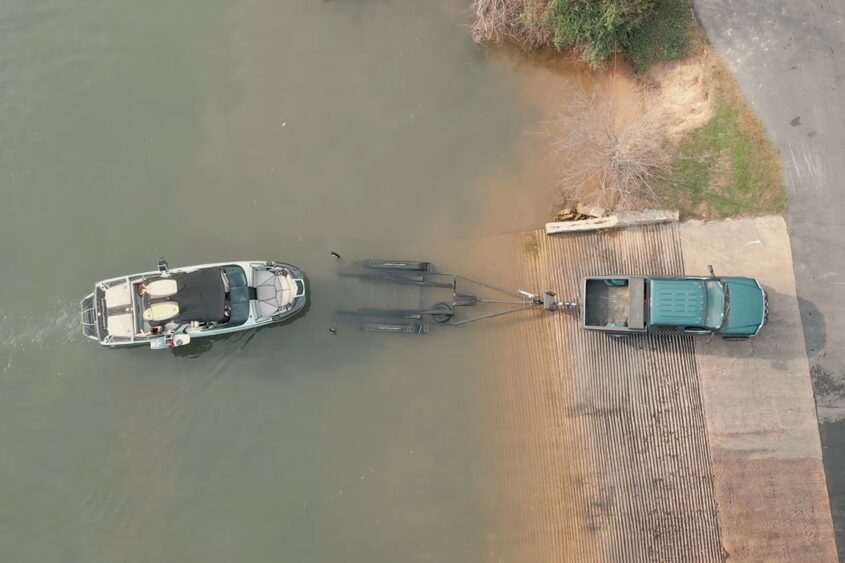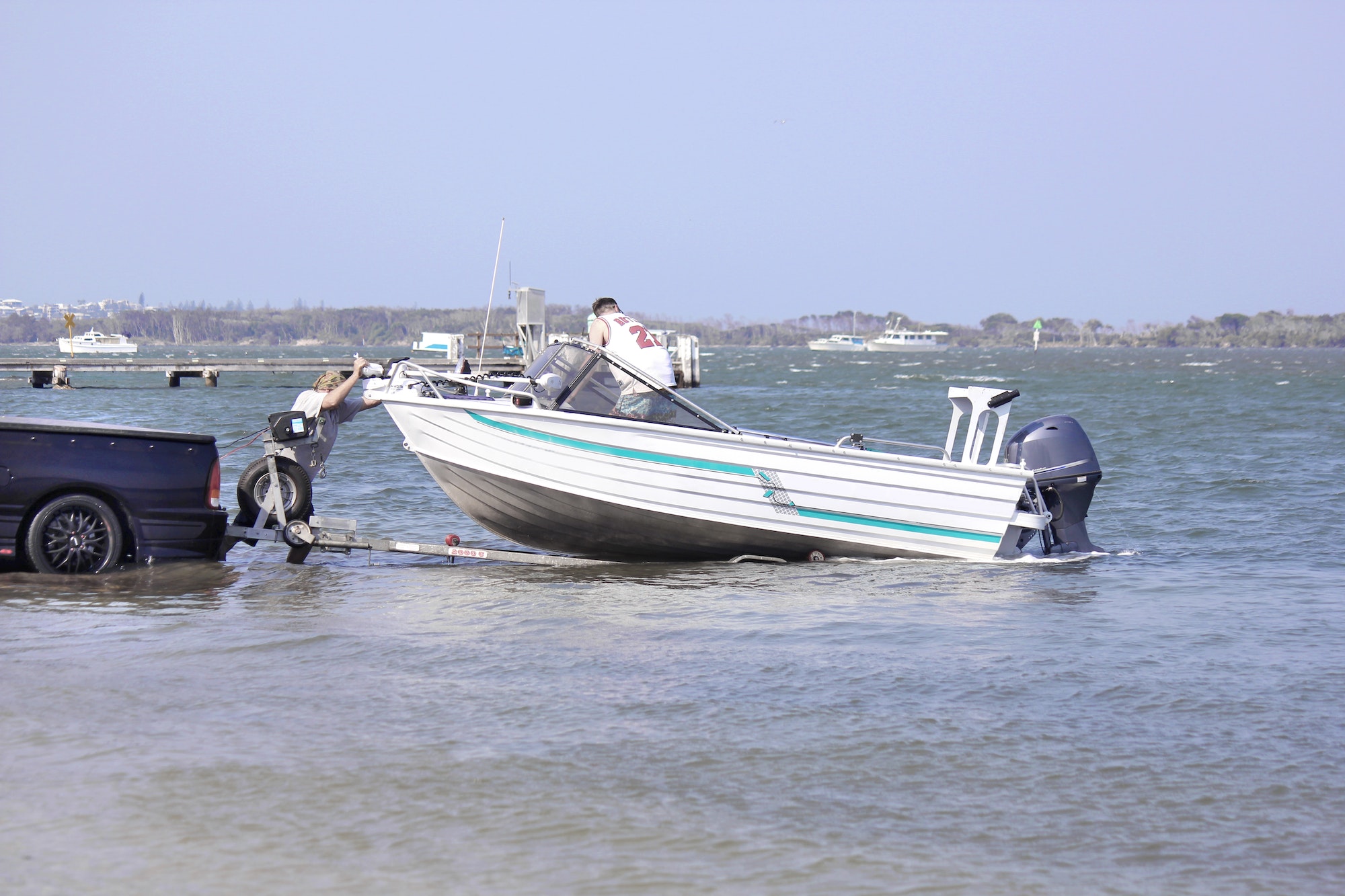So, you’ve got a shiny new boat, and you’re ready to take it out for a sail. But wait, how do you get the boat onto the trailer safely and securely? No sweat, we’ve got your back.
Imagine placing your boat on the trailer, only for it to be crooked or unsteady. A complete disaster, right? On the flip side, imagine understanding and executing the loading process smoothly, without a hitch. That second scenario seems much more appealing, doesn’t it? That’s why we’ve broken down this seemingly daunting task into a bunch of simple steps. Follow our guide, and you’ll be loading your boat onto your trailer like a pro in no time!
Let’s Dive Right Into the Process
Step 1: Give Your Trailer the Once-Over
Before you even touch the boat, your trailer needs a health check. Like a pre-flight checklist for pilots, this is a pre-sail checklist for boaters. Look at the tires- are they inflated right? Do the lights flash in response? Are the brakes in good working condition? Is the hitch firm and secure? These all sound like small things, but they’re essential.
Another important consideration is the height of the trailer. It should be adjusted to level with your boat’s height. Think of it as picking out the perfect pair of shoes for an outfit – they need to match and feel comfortable. Trust us, it’s going to make the next steps a whole lot easier!
Step 2: Get Your Trailer Ready and Set
Now for the fun part. Think of your trailer as a little kid on a hot day – it’s time to give the trailer a good soak. Submerge the trailer in the water, ensuring the bunks are just kissed by the water’s surface. What’s that? Your trailer use rollers instead? No problem – they need to get wet too.
Step 3: A Gentle Approach
Now pay close attention because this is a pivotal moment. Think about gently steering a shopping cart down a crowded supermarket aisle. Carefully drive your boat to the trailer, focusing on maintaining alignment just right. Keep the boat straight, and ensure the keel sits in line with the trailer’s midline. Trust me, it’s a sight to behold when executed perfectly.
Step 4: Time to Cruise onto the Trailer
Guiding your boat onto the trailer skillfully is nothing short of an art form. Keep a steady hand and a sharp eye on the keel’s position as the boat approaches the trailer. Once aboard, align your boat again, guaranteeing that it sits pretty, and lined up perfectly with the bunks or rollers.
Step 5: Make it Steady and Secure
You’ve reached the final stretch. Now, lock your boat in place using straps, ropes, or tie-downs. This prevents the boat from doing an awkward dance during the journey. Consider the way you’d fasten your bike in a bustling city – super tight and doubly locked!
Step 6: The Victory Moment, The Departure
Cheers! With the boat secure and stable, it’s time to smoothly roll out of the water and hit the road. Keep the trailer steady, the boat centered, and your spirits high. Remember to do a final check before you set sail on the open road. After all, it’s better to be safe than sorry.
So there you have it, folks. With these detailed steps, loading your boat onto a trailer will soon seem like second nature. Sail on!

Loading a Boat on a Trailer in a Windy Weather
Sometimes Mother Nature has other plans. Maybe a gusty wind just sprung up, turning your calm boat-trailer loading day into a challenge. Now you’ve got that nagging question – should you wait it out or tackle the task head-on? If you’re an adventurous soul who likes to take the bull by the horns, we’ve got some tips for you:
Weather Forecast Check: Yes, high winds can be a nuisance, but they can’t dampen your spirit or safety, right? So, before you begin loading, have a quick look at the forecast. If high-speed winds threaten to rise, it might be worth rescheduling your boating day for calmer conditions.
Trailer-Ready, Captain!: Remember how your tie flutters on a windy day? You surely wouldn’t want your trailer doing the same. To keep your trailer steady, ensure that it’s set up correctly and anchored firmly to the ground. It can make a world of difference when gusts try to stir things up.
Eyes on Deck: In gusty winds, an extra pair of eyes can be a lifesaver. Having a spotter on deck can streamline the process, giving you real-time directions and potentially preventing any unexpected mishaps.
Channel Your Inner Tortoise: Remember Aesop’s fable of “The Tortoise and the Hare?” It’s time to channel the tortoise’s wisdom. Despite the wind playing tug-of-war, maintain a slow, steady, and disciplined approach. No hasty moves!
The Power of Bow and Stern Lines: In challenging weather, these lines are your best friends. They help you maintain control over the boat’s movement. They can keep your boat centered and prevent it from swaying too much, whether you like to cha-cha or not.
Lock it Down: Now once your boat is ready sitting snug on the trailer, make sure it’s secured just right. It’s the last line of defense against the wind, keeping your boat from becoming a musical instrument in the wind’s hands.
Regardless of what weather conditions the day comes up with, these tips should put you on the steadier path. So, face the challenge head-on and make loading your boat a breeze (pun intended). Now, who said sailing had to be limited to water? Adventure awaits!

Common Mistakes When Placing a Boat on a Trailer
| Common Mistakes | How to Avoid them |
|---|---|
| Incorrect Trailer Positioning | The key to a smooth boat loading process is to ensure your trailer is positioned correctly in the water. It should align with the centerline of the boat. So, think of it as parking your car in just the right spot. It can take a few attempts, but it’s spot on once you get the hang of it. |
| Not Properly Securing the Boat | You’ve got your boat on the trailer, but if it’s not secured properly, it’s like a dog trying to run away without a leash. Tie it down securely using straps, ropes, or tie-downs. It’s like a safety belt for your boat, ensuring it doesn’t make any unnecessary movements during transit. |
| Poor Weight Distribution | Remember the teeter-totter from childhood? You wouldn’t want your boat to do that on the trailer. That’s why even weight distribution is profoundly important. No excessive leaning forward or backward – let your boat sit comfortably. |
| Overloading the Trailer | Keep the trailer’s capacity in mind. Overloading it is like trying to cram all of your month’s groceries into one single bag – not a good idea. Your boat, plus the additional equipment, should not exceed the maximum load your trailer is designed to carry. |
| Not Checking Trailer and Boat Equipment | This is like looking both ways before you cross a street. Whether it’s the trailer’s tires, brakes, lights, hitch, or your boat’s battery, fuel, and steering – check and recheck! Give them a once-over before loading to avoid the risk of potential problems that could crop up during transportation. |

FAQs
What Equipment do I need to place a boat on a trailer?
To place a boat on a trailer, you will need a trailer designed to transport your boat, a tow vehicle with the appropriate towing capacity, straps or tie-downs to secure the boat to the trailer, a winch or other device to pull the boat onto the trailer, and safety equipment such as life jackets, navigation lights, and fire extinguisher.
What should I remember when placing a boat on a trailer?
Placing a boat on a trailer requires attention to detail, and the key things to remember include ensuring that the trailer is the correct size and weight capacity for your boat, positioning the trailer correctly in the water, and securing the boat correctly using straps ropes, or tie-downs. Proper weight distribution and not overloading the trailer are also crucial. It is essential to check the trailer and boat equipment before loading and to use safety equipment such as life jackets, navigation lights, and fire extinguishers.
Why is it essential to place a boat on a trailer correctly?
It is important to correctly place a boat on a trailer to prevent damage to the boat and trailer.
Incorrect placement can cause the boat to sit crooked and rub against the sides of the trailer, which can wear down the paint or even cause holes. Additionally, if the bunks or rollers are not correctly positioned, they can damage the boat’s hull.
What happens if you don’t place a boat on a trailer correctly?
If a boat is not placed on a trailer correctly, it can damage the boat or the trailer. The boat may not sit level on the trailer, which can cause problems when towing. The bunks or rollers may be positioned under strakes or other protrusions from the bottom of the boat, which can damage the hull.
The transom may not be well supported, which can cause problems when launching or loading the boat. Bunks may not be located under interior stringers, which can cause damage to the hull.
Should a boat trailer be leveled when towing?
Yes, it would help if you tried to level the weight of your boat equally on the trailer. This will help with towing and keep the boat from shifting during transport. The weight limit is 10% of the total weight of the boat and trailer. Remember one thing when you’re finished. That is, you may use boat tying rope for this. This will help keep your boat secure on the trailer during transport.
How do you raise a pontoon boat on a trailer?
To elevate the transom of a pontoon boat on a trailer, lower the tongue of the trailer to the ground. Place a hydraulic bottle jack beneath the trailer tongue and raise the front of the trailer. Continue increasing the front of the trailer until the boat is level or slightly bowed high. Next, block the transom using a cinder or wooden blocks.
How high can a Pontoon trailer go?
The height of a pontoon trailer can vary depending on the specific model and manufacturer. However, in general, pontoon trailers can range in height from about 2 to 4 feet off the ground, depending on the size of the pontoons and the type of trailer. It’s important to ensure that the pontoon trailer you choose is the appropriate height for your pontoon boat to ensure safe and efficient loading and unloading. Additionally, it’s important to check local regulations and restrictions regarding trailer height when transporting your boat on public roads.

